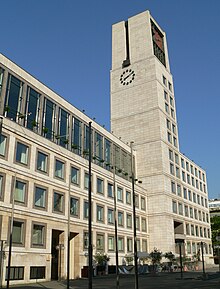Paul Stohrer
Paul Stohrer (born August 3, 1909 in Stuttgart , † June 30, 1975 there ) was a German architect and university professor .
Life
Paul Stohrer began to study engineering at the Staatliche Höhere Bauschule Stuttgart in 1927, which he completed in 1934 - after an interruption between 1928 and 1932 - with the examination for the intermediate construction service. From 1933 to 1934 and from 1940 to 1944 he studied architecture at the Technical University of Stuttgart , where he was a student of Paul Bonatz and Paul Schmitthenner , with whom he passed his main diploma examination in 1944. He then worked as a freelance architect in Stuttgart, where he became one of the most important post-war architects in the two decades between 1950 and 1970. He also created sets and directed the theater. Stohrer was considered a colorful personality who loved fast cars and extravagant appearances.
In 1957 Stohrer was appointed State Building Councilor, in 1959 State Building Councilor. From 1947 he taught as a lecturer at the Stuttgart State Building School (today Stuttgart University of Technology ). From 1959 to 1972 Paul Stohrer held the post of professor for the field of design and interior design .
His early works included the renovation of the destroyed Berlin film theater Roxy-Palast (1951 together with Bruno Meltendorf) and the film casino (in the bazaar) in Munich. In the Stuttgart area, Stohrer designed, among other things, the State Theater Stuttgart (Chamber Theater), the Stuttgart City Hall (in collaboration with Hans Paul Schmohl ), the Villa Domnick II in Nürtingen and the building of the Chamber of Crafts on Türlenstrasse in Stuttgart.
In Stohrer's projects a proximity to the buildings of classical modernism is often recognizable. However, Stohrer's own architectural language is primarily characterized by its versatility. While the elegant-looking Stohrer office and residential building in Herdweg in Stuttgart with its large glass fronts heralds the transparency and lightness of modernity, the now destroyed Radio Barth commercial building in Stuttgart and the Dr. Domnick in Nürtingen, with its strong exposed concrete, is much more enclosed and heavier. With the latter in particular, Stohrer's keen sense of building in the landscape and the convincing balance between open and closed areas, which only allow views at specifically set points, are revealed.
Shortly before his 66th birthday, Paul Stohrer died in Stuttgart as a result of a heart attack.
Buildings and designs (selection)
- 1948: Mausefalle cabaret in Stuttgart
- 1951: Film-Casino Odeonsplatz in the bazaar in Munich
- 1951: Conversion of the destroyed Roxy-Palast film theater in Berlin-Friedenau (with Bruno Meltendorf)
- 1952: Administration building of the Aachen and Munich fire insurance company in Stuttgart
- 1953–1954: Sulzberger House in Stuttgart
- 1954: Administration building for the Süddeutsche Holzberufsgenossenschaft in Stuttgart
- 1956: Reconstruction of the large house of the State Theater in Stuttgart
- 1956: Stuttgart City Hall (with Hans Paul Schmohl)
- 1957/58 residential building in Stuttgart-Schönberg
- 1958: Hofbräueck office building in Stuttgart
- 1959: City Theater in Mönchengladbach (demolished in 2012)
- 1961: Moroshito summer house in Dingelsdorf on Lake Constance
- 1961: Stohrer office and residential building in Stuttgart
- 1962: Building of the Stuttgart Chamber of Crafts
- 1963: Iduna insurance office building in Munich
- 1966: Atelier in the Schellenkönig in Stuttgart
- 1966: Radio Barth office building in Stuttgart (demolished in 2000)
- 1967: House and gallery building Dr. Domnick in Nürtingen
- 1974: Office building in Göppingen
Awards
- 1963: Paul Bonatz Prize for the Stohrer office and residential building in Stuttgart
literature
- Edeltrud Geiger-Schmidt: "Hemminger Himmelsleitern". The future-oriented high-rise terrace buildings of the Schlossgut residential park . In: Preservation of monuments in Baden-Württemberg , 41st year 2012, issue 2, p. 119 f. ( PDF )
- Ursula Grammel: Paul Stohrer 1909–1975. Architect during the economic miracle. Edition Axel Menges, Fellbach 2012, ISBN 978-3-936681-52-9 . (also dissertation, University of Stuttgart, 2011.)
- Amber Sayah: A Hero's Life. The Stuttgart architect Paul Stohrer (1909–1975). In: Bauwelt , 84th year 1987, issue 31.
- Amber Sayah: Architect in the Economic Wonderland . (Review of the monograph by Ursula Grammel) In: Stuttgarter Zeitung of December 22, 2011. (online)
Web links
- Short CV and list of works by Paul Stohrer at the Southwest German Archive for Architecture and Civil Engineering (SAAI)
- Architect portrait Paul Stohrer
- Ursula Grammel: The architect Paul Stohrer. Insights into his work . Lecture on November 24, 2007 at the Domnick Collection, Nürtingen.
| personal data | |
|---|---|
| SURNAME | Stohrer, Paul |
| BRIEF DESCRIPTION | German architect and university professor |
| DATE OF BIRTH | August 3, 1909 |
| PLACE OF BIRTH | Stuttgart |
| DATE OF DEATH | June 30, 1975 |
| Place of death | Stuttgart |



